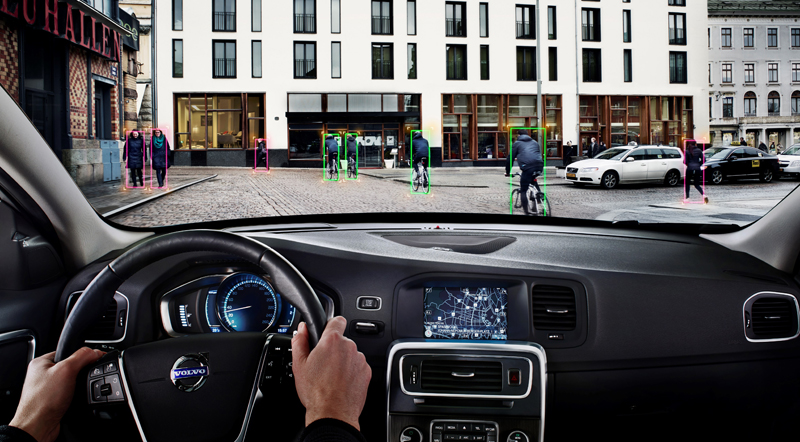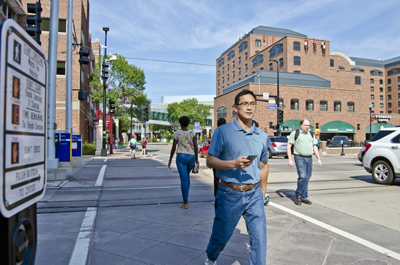Eyes on the Streets
Apps, Intelligent Transportation System Improving Safety

Volvo
Volvo's City Safety features use radar and cameras to detect pedestrians and bicyclists and warn the driver or activate brakes.
On a busy city street in Minneapolis, a blind pedestrian needs help figuring out his next move. He pulls out a cell phone, points it straight ahead and taps the screen once. A recorded voice provides information about his location, the street’s geometry and what direction he’s heading.
He decides to continue forward. This time he taps the screen twice and the phone transmits a message to the traffic light requesting a signal change—a 21st century twist on the old push button-activated beacon. While crossing the street, the automated voice is with him all the way, advising how many feet are left to go and how much time is left on the countdown timer.
The man was operating the Mobile Accessible Pedestrian Signal (MAPS) system, a mobile app developed by Chen-Fu Liao, senior systems engineer at the Minnesota Traffic Observatory housed at the University of Minnesota. Liao has high hopes for what the system could mean for a uniquely vulnerable group of users that numbers 3.5 million strong in the U.S. and is projected to double by 2030.
“We are talking to a lot of big cities on the East Coast,” said Liao, whose creation is currently being field tested and refined for public deployment.
MAPS is one example of a booming group of technologies, ranging from apps to software in cars to connected infrastructure, that are poised to improve pedestrian and bicycle safety in the coming years. While much of the buzz around intelligent transportation systems (ITS) has centered on self-driving cars, the potential impacts to non-motorized travel are considerable and perhaps under appreciated.
“Autonomous has become the shiny object that everyone wants to talk about, but there are a lot more capabilities that regular drivers are going to benefit from,” said General Motors Director of Safety Strategy John Tapp.
Experts say cell phones could be the game changer for pedestrian safety. According to the Pew Research Center, more than 90 percent of Americans own a cell phone and over two-thirds of them own a smartphone capable of downloading third party software. In effect, the majority of people walking the streets now have beacons in their pockets and purses capable of communicating with other machines—including cars, traffic equipment and other mobile devices. Now safety-minded developers from Detroit to Silicon Valley are getting in the game, testing what can be accomplished with that link.
Public Sector Partnership
Pushing the safety gains from ITS to the next level will in some cases require parallel efforts from the public sector. The MAPS system, for example, relies on traffic devices being equipped to communicate with it, or at the very least, cities making data about signal timings and intersection designs readily available for a database. Otherwise, researchers would have to laboriously collect that information block by block, traffic light to traffic light.
“We want to implement MAPS at a much wider scale by setting it up to communicate directly with cities’ central controller systems, rather than needing information from individual signals,” Liao said. “Some big cities are still using traffic controllers that are 50 years old. It will require some mentality change and it will require some catch up by infrastructure agencies.”

University of Minnesota Center for Transportation Studies
Chen-Fu Liao, a researcher at the University of Minnesota, tests
his app for blind pedestrians.The federal government is tracking the progress of these technologies to ensure it has a full sense of the landscape. In 2014, the U.S. Department of Transportation began compiling a database of vehicle to pedestrian (V2P) technologies through its Intelligent Transportation System Joint Program Office (ITS JPO) Connected Vehicle Program. The list includes technologies that were known to the USDOT and those located through a technical scan of journals, external catalogs and the Internet. As of early September, the list includes 86 V2P technologies at varying stages of development.
In some cases, the USDOT is funding development of this technology. Mike Pina, communications and outreach program manager for the ITS JPO, pointed to the grant-funded MAPS and USDOT research on a signalized crosswalk app as examples of federal dollars being applied for potentially high-impact technologies. The crosswalk app is designed to alert bus drivers when pedestrians could be in harm’s way as they prepare to make a turn.
This year the USDOT hosted a Smart City Challenge that sought bold proposals from cities that would leverage technology to make their transportation systems safer and more efficient. Challenge winner Columbus, Ohio, proposed a far-reaching plan that includes the creation of self-driving shuttles, smart signals, apps and corridors for autonomous vehicles, with a target of reducing crashes 15 percent by 2035. The city was rewarded with a $40 million USDOT grant and $10 million in matching funds from Microsoft co-founder Paul Allen’s Vulcan Inc.
Technologies Becoming Standard
The development of ITS and advanced vehicle safety technologies has become a competitive business for the world’s automakers, many of which have invested in state-of-the-art facilities dedicated to that purpose.
Last summer, GM opened a new 52-acre Active Safety Test Area at its Milford Proving Ground near Detroit. Among the site’s features are a 16-acre area designated for autonomous vehicle testing, a six-lane highway complete with on/off ramps, and a pedestrian test area with a simulated intersection with a specially designed rig for accurate dummy movement.
“We’ve got the ability to robotically test cars, almost like playing a video game from our [observation] tower,” Tapp said.
Much of the work taking place in Milford is to refine crash avoidance technologies that are becoming more common in new vehicles. According to Tapp, some of the best success in the field to date has been with radar technologies that sense obstructions and can warn drivers to take action or even trigger automatic braking. However, Tapp said radar technology does have some drawbacks—it is expensive and not effective at determining what specific kind of object is ahead. But when radar is supplemented with camera technologies that can recognize the shapes of faces and pedestrians, he said the potential grows exponentially.
Tapp said GM is already seeing safety gains with the packages in today’s vehicles. He estimated such technologies will eventually provide benefits in about 80 percent of non-impaired crashes.
“The whole field has completely exploded. People love these features,” Tapp said.
Volvo is another automaker that is looking to the future with an ITS development initiative called IntelliSafe. A suite of technologies under its City Safety umbrella are geared toward reducing crashes with bicyclists and pedestrians.
“Our City Safety technology with automatic emergency braking is standard across all our cars,” said Volvo Technology and Product Communications Manager Jim Nichols. “Pedestrian detection and cyclist detection with autobrake is also available on all cars and is standard on the XC90 [sports utility vehicle] and S90 [sedan]. With the S90 we introduce large animal detection with autobrake, which works to identify deer, elk, moose, etc. to prevent a collision.”
Last year, Volvo unveiled a bicycle helmet designed in collaboration with sports gear manufacturer POC and Ericsson that communicates the positions of riders to connected vehicles.
Moving forward, Nichols said the company will maintain a focus on preparing for a day when vehicles do most of the work. According to the company’s polling, Americans are ready. A survey released by Volvo in July found that 68 percent believe autonomous vehicles can reduce accidents and 69 percent feel they can make their families safer.
“We are continuing to work on autonomous safety technologies to achieve our Vision 2020, which states that no one should be killed or seriously injured in a new Volvo by 2020,” Nichols said.
Karl Vilacoba is a freelance writer based in New Jersey.